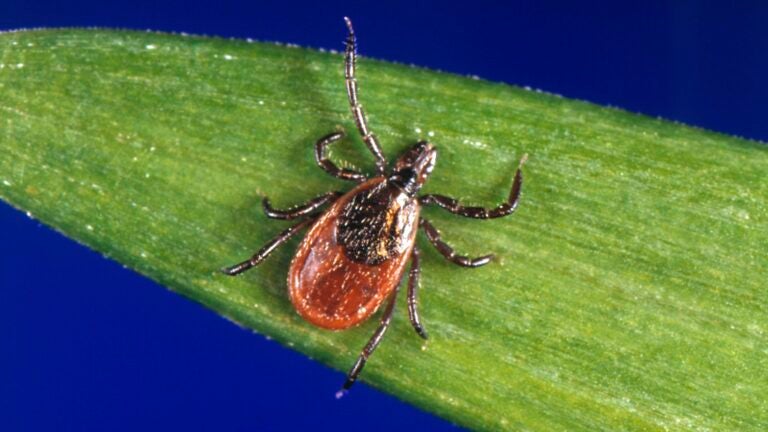Address newsletter
Get the latest news on buying, selling, renting, home design, and more.

We know you’re eager to hear from R. Wayne Mezzitt, the Globe’s Ask the Garden Guy, but unfortunately, he’s under the weather, due to the effects of something we all risk when we go outside: tick-borne disease.
Wayne has come down with babesiosis, one of three common tick-borne diseases in Massachusetts. It’s carried by the blacklegged tick (often referred to as deer tick). While he recovers, we thought we’d talk about ticks: what are the risks, what can you do to help protect yourself, and what happens if you’re bitten?
“What I tell people is that, unless you’re in downtown Boston standing in the middle of Commonwealth Ave., you should assume that there are ticks around you,” said Dr. Catherine Brown, Massachusetts state epidemiologist and a veterinarian with the Department of Public Health.
People with tick-borne diseases often report being gardeners, Brown said. While not a direct causal line, it points to a likelihood that they are also outdoor types who spend time where ticks do, too.
The blacklegged tick is most commonly associated with Lyme disease, followed by a bacterial disease called anaplasmosis, and babesiosis, a disease caused by a red blood cell parasite. They can also transmit two less common diseases, Borrelia Miyamotoi and Powassan virus.
It isn’t clear how large the tick population is, but officials judge by how many humans report illness after a bite from an infected tick. And ticks can carry more than one disease in one bite.
“I don’t think that the severity of any of these cases has changed over time, but certainly the frequency has changed over time,” said Dr. Daniel Kuritzkes, chief of the Division of Infectious Diseases at Brigham and Women’s Hospital.
State experts look to hospital emergency departments for trends in order to assess risk, which represent a fraction of total tick-related cases. In 2023, 2,215 visits were attributed to tick-related illness, a small percentage of overall visits. Brown said that while levels are comparatively low at this time, reports of exposures have “exploded” over recent decades in New England.
That growth can partially be attributed to our warming climate, which helps ticks overwinter, as well as increased deer populations, which host ticks.
Brown offered tips to reduce your exposure:
Integrated pest management techniques can supplement risk reduction, such as limiting deer-attractive plantings, trimming yard edges, and creating a border of at least 3 feet between lawns and stone walls or woodlands, which are habitats for ticks and their hosts, such as mice and deer.
“Deer ticks prefer wooded areas and forest edges, and [in] places that have hosts that deer ticks like … I think your risk is probably higher,” said Dr. Jim Fredericks, chief entomologist and senior vice president of public affairs at the National Pest Management Association, which maintains the site Tick Talk to educate about the risk.
“If your garden is a raised bed in an urban area, your risk is probably lower,” Fredericks said.
If a tick attaches to your body, use a fine tweezer to get between it and your skin, pulling outward to encourage its release. Brown said it’s a good idea to consult with a physician and to monitor for fever, headache, chills, and fatigue.
If a tick has been attached for a day or more, you may want to take additional steps.
“What we advise as infectious disease experts is to receive a prophylactic dose of doxycycline within 72 hours of the tick bite to prevent Lyme disease, rather than waiting to see if you get it or not,” Kuritzkes said.
Both Lyme and anaplasmosis can be treated with doxycycline, said Kuritzkes, noting that some who contract Lyme — especially those not diagnosed early — report longer-term symptoms. Babesiosis, which can be compared to malaria and causes severe anemia, requires both antibiotic and antiparasitic drugs. In June, Tufts Medical Center began a trial to assess the use of a malaria drug against babesiosis.
Experts say fear shouldn’t keep you inside.
“I know that there are some people who have become so … afraid of tick-borne diseases that it prevents them from doing things that they enjoy,” said Brown. “I don’t encourage that.”
While nothing is 100 percent protective, she said, cautionary tactics and medical advice help.
Please join us in wishing Wayne a swift and complete recovery so he can return to the great outdoors soon.
Lindsay Crudele can be reached at [email protected]. Send your gardening questions to [email protected]. We are banking them until Wayne recovers.
Correction: Due to incorrect information provided to the Globe, previous versions of this article offered incorrect advice on taking doxycycline.
Get the latest news on buying, selling, renting, home design, and more.





Stay up to date with everything Boston. Receive the latest news and breaking updates, straight from our newsroom to your inbox.
Conversation
This discussion has ended. Please join elsewhere on Boston.com